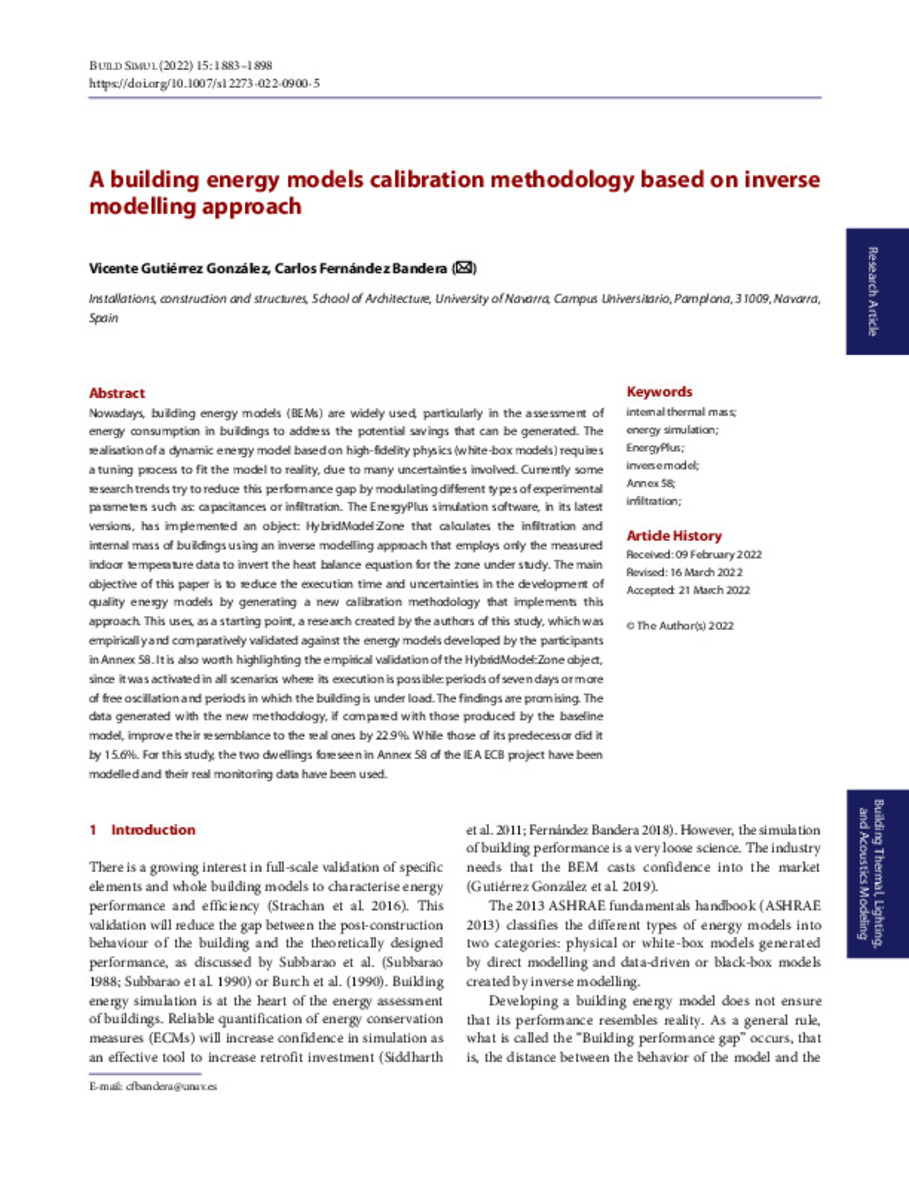Full metadata record
| DC Field | Value | Language |
|---|---|---|
| dc.creator | Gutiérrez-González, V. (Vicente) | - |
| dc.creator | Ramos-Ruiz, G. (Germán) | - |
| dc.creator | Fernández-Bandera, C. (Carlos) | - |
| dc.date.accessioned | 2023-02-28T08:41:58Z | - |
| dc.date.available | 2023-02-28T08:41:58Z | - |
| dc.date.issued | 2020 | - |
| dc.identifier.citation | Gutiérrez-González, V. (Vicente); Ramos-Ruiz, G. (Germán); Fernández-Bandera, C. (Carlos). "Empirical and comparative validation for a building energy model calibration methodology". Building Simulation. 20 (17), 2020, 1883 - 1898 | es_ES |
| dc.identifier.issn | 1996-8744 | - |
| dc.identifier.uri | https://hdl.handle.net/10171/65580 | - |
| dc.description.abstract | Nowadays, building energy models (BEMs) are widely used, particularly in the assessment of energy consumption in buildings to address the potential savings that can be generated. The realisation of a dynamic energy model based on high-fidelity physics (white-box models) requires a tuning process to fit the model to reality, due to many uncertainties involved. Currently some research trends try to reduce this performance gap by modulating different types of experimental parameters such as: capacitances or infiltration. The EnergyPlus simulation software, in its latest versions, has implemented an object: HybridModel:Zone that calculates the infiltration and internal mass of buildings using an inverse modelling approach that employs only the measured indoor temperature data to invert the heat balance equation for the zone under study. The main objective of this paper is to reduce the execution time and uncertainties in the development of quality energy models by generating a new calibration methodology that implements this approach. This uses, as a starting point, a research created by the authors of this study, which was empirically and comparatively validated against the energy models developed by the participants in Annex 58. It is also worth highlighting the empirical validation of the HybridModel:Zone object, since it was activated in all scenarios where its execution is possible: periods of seven days or more of free oscillation and periods in which the building is under load. The findings are promising. The data generated with the new methodology, if compared with those produced by the baseline model, improve their resemblance to the real ones by 22.9%. While those of its predecessor did it by 15.6%. For this study, the two dwellings foreseen in Annex 58 of the IEA ECB project have been modelled and their real monitoring data have been used. | es_ES |
| dc.description.sponsorship | This research was funded by the Government of Navarra under the project “From BIM to BEM: B&B” (ref. 0011- 1365-2020-000227). We would like to thank the promoters of Annex 58, the possibility of accessing the data of the houses. Without this data, it would not have been possible to complete this work. Open Access funding provided thanks to the CRUE-CSIC agreement with Springer Nat | es_ES |
| dc.language.iso | spa | es_ES |
| dc.publisher | Springer | es_ES |
| dc.rights | info:eu-repo/semantics/openAccess | es_ES |
| dc.subject | Internal thermal mass | es_ES |
| dc.subject | Energy simulation | es_ES |
| dc.subject | EnergyPlus | es_ES |
| dc.subject | Inverse model | es_ES |
| dc.subject | Annex 58 | es_ES |
| dc.subject | Infiltration | es_ES |
| dc.title | Empirical and comparative validation for a building energy model calibration methodology | es_ES |
| dc.type | info:eu-repo/semantics/article | es_ES |
| dc.description.note | This article is licensed under a Creative Commons Attribution 4.0 International License | es_ES |
| dc.identifier.doi | 10.3390/s20175003 | - |
| dadun.citation.endingPage | 1898 | es_ES |
| dadun.citation.number | 17 | es_ES |
| dadun.citation.publicationName | Building Simulation | es_ES |
| dadun.citation.startingPage | 1883 | es_ES |
| dadun.citation.volume | 20 | es_ES |
Files in This Item:
Statistics and impact
Items in Dadun are protected by copyright, with all rights reserved, unless otherwise indicated.






